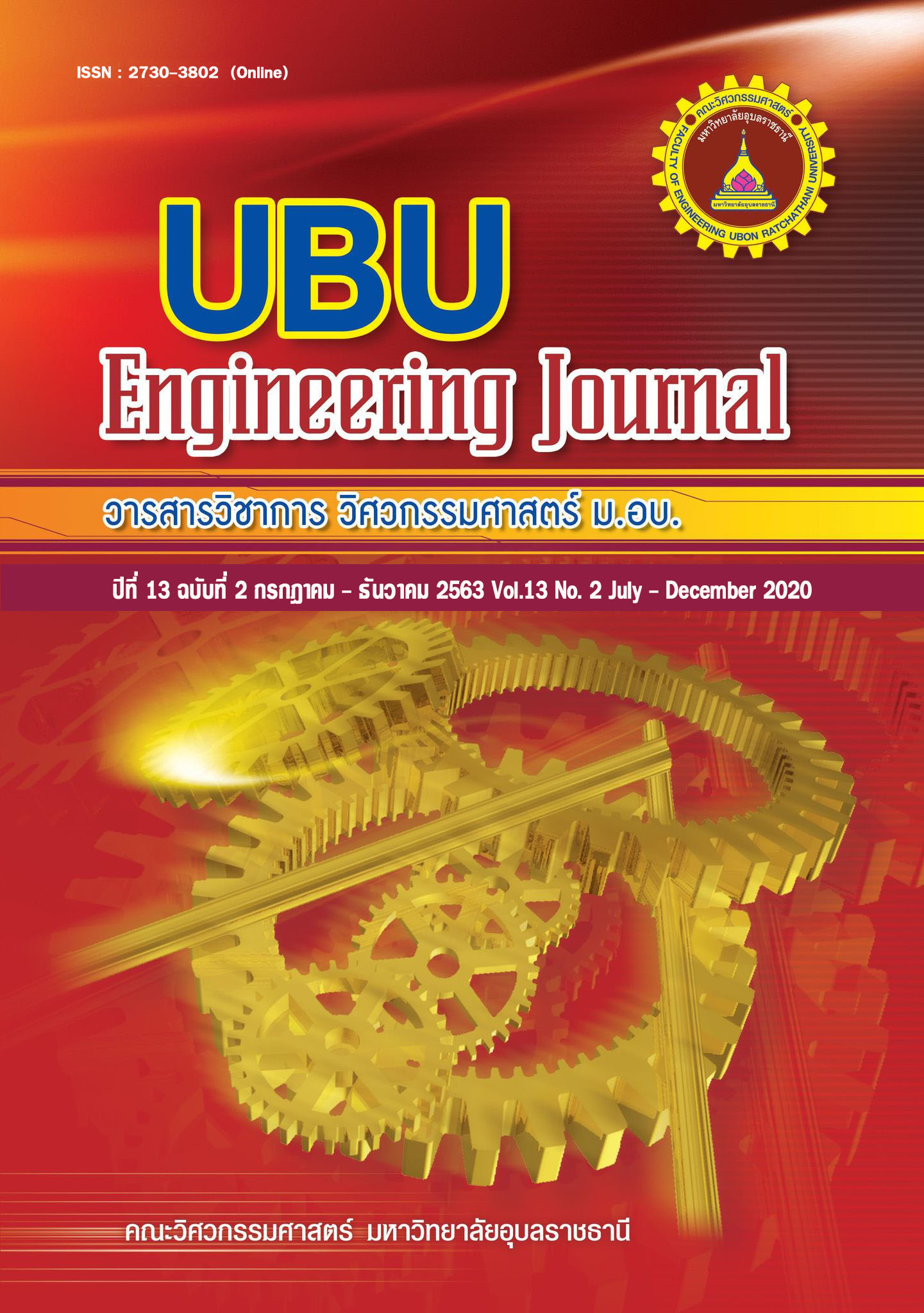Influence of nanosilica particle size on the sulfate, acid resistances and bonding strength of cement mortar containing nanosilica
Main Article Content
Abstract
This research presents sulfate and acid resistances with bonding strength and effect of a sustained load on the bonding strength of deformed bar in concrete using cement mortar containing nanosilica with particle sizes of 12, 20, and 40 nm. For the sulfate and acid resistances investigation, the compressive strength, expansions and weight loss including the bonding strength and sustained load of cement mortar with various nanosilica. The test results indicated that the particle sizes of nanosilica directly affected the sulfate and acid resistances. Nanosilica with particles size of 40 nm gave the highest compressive strength while the expansion and weight loss of cement mortar lower than those of cement mortar with Portland cement types I and V. In the part of bonding strength and effect of a sustained load on the bonding strength of deformed bar in concrete using cement mortar containing nanosilica. The results showed that the particle sizes of nanosilica also affected the bonding strength and creep behavior. Cement mortar with nanosilica particle size of 40 nm gave a highest bonding strength and sustained load than those of nanosilica particle size of 12 and 20 nm, including the epoxy resin.
Article Details
References
mechanism of sulfate attack on concrete under freeze-thaw cycles. Journal of Wuhan University of Technology-Materials Science. 2013; 28(6): 1172-1176.
[2] Chindaprasert P, Jaturapitakkul C. Cement pozzolan and concrete. Thailand Concrete Association. 2008; 11:235-340.
[3] คุณาพจน์ วงษ์คำ, เชิดศักดิ์ สุขศิริพัฒนพงศ์, เสริมศักดิ์ ติยะแสงทอง, จักษดา ธำรงวุฒิ, ชยกฤต เพชรช่วย. กำลังอัดและโครงสร้างจุลภาคของดินลูกรัง-กากกาแฟปรับปรุงด้วยเถ้าลอยจีโอโพลีเมอร์. วารสารวิชาการ วิศวกรรมศาสตร์ ม.อบ. 2561; 11(2): 65-73.
[4] Ye Q, Zhang Z, Kong D, Chen R. Influence of nano-SiO2 addition on properties of hardened cement paste as compared with silica fume. Construction and Building Materials. 2007; 21: 539-545.
[5] Veronica S, Alisson C, Noan T, Eduardo S, Fernanda S, Sergio N. Mechanical and microstructural characterization of geopolymer concrete subjected to fatigue. Journal of Materials Research and Technology. 2018; 7(4): 566-570.
[6] Saccani A, Magnaghi, V. Durability of epoxy resin-based materials for the repair of damaged cementitious composites. Cement and Concrete Research, 1999; 29: 95-98.
[7] Li H, Zhang M.H, Ou J.P. A study on mechanical and pressure-sensitive properties of cement-mortar with nanophase materials. Cement and Concrete Research. 2004; 34: 435-438.
[8] Zhang M.H, Li H, Ou J.P. Flexural fatigue performance of concrete containing nano-particles for pavement. International Journal of Fatigue. 2007; 29: 1292-1301.
[9] Jo B.W, Kim C.H, Tae G.H, Park J.B. Characteristics of cement mortar with nano-SiO2 particles. Construction and Building Materials. 2007; 21: 1351-1355.
[10] Haruehansapong S, Pulngern T, Chucheepskul S. Effect of the partical size of nanosilica on the compressive strength and the optimum replacement content of cement mortar containing nano-SiO2. Construction and Building Materials. 2014; 50: 471-477.
[11] Haruehansapong S, Pulngern T, Chucheepskul S. Effect of nanosilica partical size on the water permeability, abrasion resistance drying shrinkage, and repair work properties of cement mortar containing nano-SiO2. Advance in Materials Science and Engineering. 2017; 1-11.
[12] Jaison J, Ahmed B, Yen S.C, Alain D, Michael K.D. Review on nanoparticles and nanostructured materials: history, sources, toxicity and regulations. Beilstein Journal of Nanotechnology. 2018; 9: 1050-1074.
[13] Paratibha A, Rahul P.S, Yogesh A, Raja R.H. Use of nano-silica in cement based materials-a review. Cogent Engineering. 2015; 2(1): 1-11.
[14] Iqbal G, Ali A.J, Maan S.H. Sulfate and chloride resistance of nanosilica and microsilica contained self-consolidation concretes. Kufa Journal of Engineering. 2018; 9(4): 23-44.
[15] Nader G, Iani B, Meysam. Sulfate resistance of nanosilica and microsilica contained mortars. Aci Materials Journal. 2016; 113(4): 459-469.
[16] Vital A, Klotz U, Graulet T, Mueller R, Kammler H.K, Pratsinis S.E. Synthesis of spherical, non-aggregated silica nanoparticle. NATO Advanced Research Workshop on Nanostructured Materials and Coatings. 2002; 102: 203-210.
[17] วิเชียร ชาลี, กิรติกร เจริญพร้อม. การต้านทานการกัดกร่อนเนื่องจากซัลเฟตของจีโอพอลิเมอร์คอนกรีตจากเถ้าถ่านหิน วารสารและวิจัยพัฒนา มจธ. 2555; 35(2): 157-171.
[18] ASTM C1437. Standard Test Method for Flow of Hydraulic Cement Mortar. West Conshohocken: ASTM International; 2007.
[19] ASTM C109. Standard Test Method for Compressive Strength of Hydraulic Cement Mortar (Using 2 in. or [50 mm.] Cube Specimens). West Conshohocken: ASTM International; 1997.
[20] ASTM C490. Standard Practice for Use of Apparatus for the Determination of Length Change of Hardened Cement Paste, Mortar and Concrete. West Conshohocken: ASTM International; 2001.
[21] ASTM C490. Standard Test Method for Weight Loss (Mass Loss) of Sheet Steel During Immersion in Sulfuric Acid Solution. West Conshohocken: ASTM International; 2016.
[22] ASTM C234. Standard Test Method of Comparing Concrete on the Basic of Bond Developed with Reinforcing Steel. West Conshohocken: ASTM International; 1997.
[23] ASTM D2290. Standard Test Method for Tensile, Compressive, and Flexural Creep and Creep-Rupture of Plastics. West Conshohocken: ASTM International; 2010.
[24] ธีรติ ศรีจันทร์, บุรฉัตร ฉัตรวีระ, พงษ์ศักดิ์ โชคทวีกาญจน์, สมนึก ตั้งเติมสิริกุล. การศึกษาผลของการบ่มต่อกำลังอัดของคอนกรีตที่ใช้ชนิดของปูนซีเมนต์และวัสดุประสานร่วมต่างกัน. วารสารและวิจัยพัฒนา มจธ. 2554; 34(4): 383-394.

